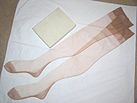
Flip-flops are a type of light sandal-like shoe, typically worn as a form of casual footwear. They consist of a flat sole held loosely on the foot by a Y-shaped strap known as a toe thong that passes between the first and second toes and around both sides of the foot. This style of footwear has been worn by people of many cultures throughout the world, originating as early as the ancient Egyptians in 1500 BC. In the United States the modern flip-flop may have had its design taken from the traditional Japanese zōri, after World War II as soldiers brought them back from Japan.
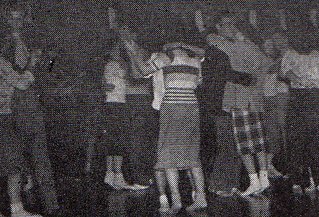
A sock hop or sox hop, often also called a record hop or just a hop, was an informal sponsored dance event for teenagers in mid-20th-century North America, featuring popular music.

Sandals are an open type of shoe, consisting of a sole held to the wearer's foot by straps going over the instep and around the ankle. Sandals can also have a heel. While the distinction between sandals and other types of footwear can sometimes be blurry, the common understanding is that a sandal leaves all or most of the foot exposed. People may choose to wear sandals for several reasons, among them comfort in warm weather, economy, and as a fashion choice. Usually, people wear sandals in warmer climates or during warmer parts of the year in order to keep their feet cool and dry. The risk of developing athlete's foot is lower than with enclosed shoes, and the wearing of sandals may be part of the treatment regimen for such an infection.
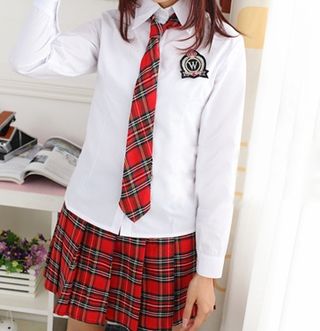
A Catholic school uniform in North America typically consists of a pleated and tartan skirt or jumper dress, Mary Jane or saddle shoes, a button-down shirt, and a sweater for girls, while boys' uniforms consist of a button-down shirt, a necktie, and dark pants. Actual school uniforms vary widely by location and individual school.

Leggings are several types of leg attire that have varied through the years. Modern usage from the 1960s onwards has come to refer to elastic close-fitting high-rise garments worn over the legs typically by women, such as leg warmers or tights. Usage from the 18th century refers to men's wear usually made of cloth or leather that is wrapped around the leg down to the ankle. In the 19th century, leggings usually referred to infants' leg clothing that were matched with a jacket, as well as leg-wrappings made of leather or wool and worn by soldiers and trappers. Leggings prominently returned to women's fashion in the 1960s, drawing from the form-fitting clothing of dancers. With the widespread adoption of the synthetic fibre Lycra and the rise in popularity of aerobics, leggings came to further prominence in the 1970s and 1980s, and eventually made their way into streetwear. Leggings are a part of the late 2010s into the 2020s athleisure fashion trend of wearing activewear outside sporting activities and in casual settings.

Bobby soxers were a subculture of young women in the mid to late 1940s. Their interests included popular music, in particular that of singer Frank Sinatra, and wearing loose-fitting clothing, notably bobby socks. Their manner of dress, which diverged sharply from earlier ideals of feminine beauty, were controversial. As a teenager, actress Shirley Temple played a stereotypical bobby soxer in the film The Bachelor and the Bobby-Soxer (1947).

The term "sweater girl" was made popular in the 1940s and 1950s to describe Hollywood actresses like Lana Turner, Jayne Mansfield, and Jane Russell, who adopted the popular fashion of wearing tight, form-fitting sweaters that emphasized the woman's bustline. The sweater girl trend was not confined to Hollywood and was viewed with alarm by some. In 1949 a Pittsburgh police superintendent even singled out the sweater girl as a symptom of the moral decline of postwar youth:
"Women walk the streets, their curves accentuated by their dresses," Superintendent of Police Harvey J. Scott said. "But our real problem is with bobby soxers. They are the sweater girls—just kids showing off their curves and apparently liking it. What kind of mothers and wives are they going to be?"
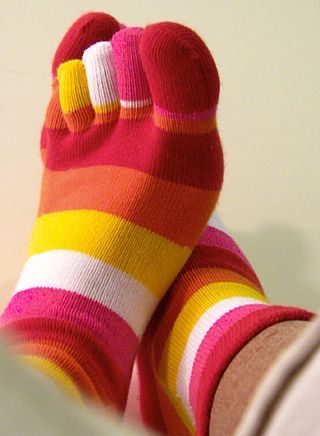
Toe socks are socks that have been knitted so that each toe is individually encased the same way as fingers within a glove.

Mary Jane is an American term for a closed, low-cut shoe with one or more straps across the instep.

Fashion in the 1990s was defined by a return to minimalist fashion, in contrast to the more elaborate and flashy trends of the 1980s. One notable shift was the mainstream adoption of tattoos, body piercings aside from ear piercing and, to a much lesser extent, other forms of body modification such as branding.

Fashion of the 1980s was characterized by a rejection of 1970s fashion. Punk fashion began as a reaction against both the hippie movement of the past decades and the materialist values of the current decade. The first half of the decade was relatively tame in comparison to the second half, which was when apparel became very bright and vivid in appearance.

Fashion in the years following World War II is characterized by the resurgence of haute couture after the austerity of the war years. Square shoulders and short skirts were replaced by the soft femininity of Christian Dior's "New Look" silhouette, with its sweeping longer skirts, fitted waist, and rounded shoulders, which in turn gave way to an unfitted, structural look in the later 1950s.

Fashion in the 1970s was about individuality. In the early 1970s, Vogue proclaimed "There are no rules in the fashion game now" due to overproduction flooding the market with cheap synthetic clothing. Common items included mini skirts, bell-bottoms popularized by hippies, vintage clothing from the 1950s and earlier, and the androgynous glam rock and disco styles that introduced platform shoes, bright colors, glitter, and satin.

Baseball stirrups, also called stirrup socks or simply stirrups, are socks that are part of a traditional baseball uniform, giving the uniform a distinctive look. Stirrup socks are usually one of a team's traditional colors, and are worn over long socks that are usually white in color. The stirrup sock lacks toe and heel sections, instead having a loop which fits within the arch of the foot. Over the years, the stirrup loop tended to get longer, exposing more of the white undersock, thus creating a look unique to baseball. Most contemporary players in Major League Baseball (MLB) do not wear stirrup socks, as uniform pants that extend all the way down to the ankle have become increasingly popular since the mid-1990s.

Hockey socks are ankle-to-thigh garments worn over protective gear by ice hockey players. They are form-fitting, and traditionally made of a cotton or synthetic rib-knit fabric.
Oxford bags were a loose-fitting baggy form of trousers favoured by members of the University of Oxford, especially undergraduates, in England from the mid-1920s to around the 1950s. The style had a more general influence outside the university, including in America, but has been somewhat out of fashion since then.

Clothing fetishism or garment fetishism is a sexual fetish that revolves around a fixation upon a particular article or type of clothing, a particular fashion or uniform, or a person dressed in such a style.
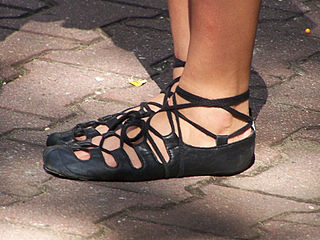
Ghillies are specially designed shoes used for several types of dance. They are soft shoes, similar to ballet shoes. They are used by women in Irish dance, by men and women in Scottish country dance, and by men and women in Scottish highland dance.
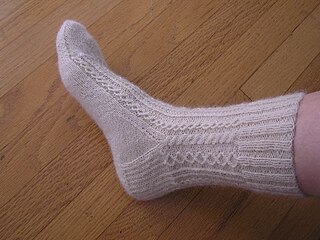
A sock is a piece of clothing worn on the feet and often covering the ankle or some part of the calf. Some types of shoes or boots are typically worn over socks. In ancient times, socks were made from leather or matted animal hair. In the late 16th century, machine-knit socks were first produced. Until the 1800s, both hand-made and machine-knit socks were manufactured, with the latter technique becoming more common in the 19th century, and continuing until the modern day.
The logos and uniforms of the Boston Red Sox have gone through a limited number of changes throughout the history of the team.




















